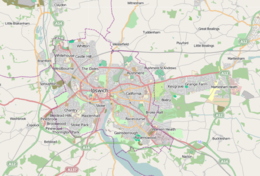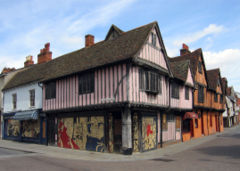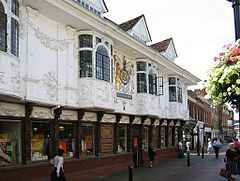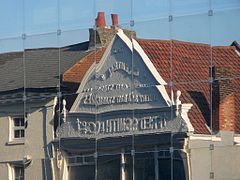
Ipswich
Did you know...
This content from Wikipedia has been selected by SOS Children for suitability in schools around the world. SOS Children is the world's largest charity giving orphaned and abandoned children the chance of family life.
| Ipswich | |
|---|---|
| Borough of Ipswich | |
| Neptune Quay Marina, Ipswich Harbour | |
| Ipswich and surrounding area | |
| Coordinates: 52°3′34″N 1°9′20″E | |
| Sovereign state | United Kingdom |
| Constituent Country | England |
| Region | East of England |
| County | Suffolk |
| Borough | Ipswich |
| Government | |
| • Type | Leader and Cabinet |
| • MPs | Ben Gummer |
| Area– [[List of English districts by area|Ranked 292nd]] | |
| • City | 15.22 sq mi (39.42 km2) |
| Population | |
| • City | [[List of English districts by population|Ranked 154th]] 133,700 |
| • Urban | Unknown |
| • Ethnicity | 90.5% White 2.1% Black 3.9% S.Asian 1.1% Chinese or Other 2.4% Mixed Race |
| ONS code | 42UD |
Ipswich (pronounced /ˈɪpswɪtʃ/) (previously Gyppeswick in variant spellings) is a non-metropolitan district and the county town of Suffolk, England. It is located on the estuary of the River Orwell. Nearby towns are Felixstowe in Suffolk and Harwich and Colchester in Essex.
The town of Ipswich overspills the borough boundaries significantly, with only 85% of the town's population living within the borough at the time of the 2001 Census, when it was the third-largest settlement in the United Kingdom's East of England region, and the 38th largest urban area in England.
The modern name is derived from the medieval name, 'Gippeswick' (also spelt 'Gipewiz', 'Gepeswiz', or 'Gypeswiz') is probably taken from the River Gipping which is the name of the non-tidal section of the River Orwell. As of 2007, the borough of Ipswich is estimated to have a population of approximately 128,000 inhabitants.
History
Under the Roman empire, the area around Ipswich formed an important route inland to rural towns and settlements via the rivers Orwell and Gipping. A large Roman fort, part of the coast defences of Britain, stood at Walton near Felixstowe (13 miles, 21 km), and the largest villa in Suffolk (possibly an administrative complex) stood at Castle Hill (north-west Ipswich).
Ipswich is one of England's oldest towns, and took shape in Anglo-Saxon times (in the 7th–8th centuries) around Ipswich dock. As the coastal states of north-western Europe emerged from the collapse of the Roman Empire, essential North Sea trade and communication between eastern Britain and the continent (especially to Scandinavia, and through the Rhine) passed through the formerly Roman ports of London (serving the Kingdoms of Mercia, the East Saxons and of Kent) and of York (Eoforwic) (serving the Kingdom of Northumbria).
Gipeswic arose as the equivalent to these serving the Kingdom of East Anglia, its early imported wares dating to the time of King Rædwald, supreme ruler of the English (616–624). The famous ship-burial and treasure at Sutton Hoo nearby (9 miles, 14.5 km) is probably his grave. The Ipswich Museum houses replicas of the Roman Mildenhall Treasure and the Sutton Hoo treasure. A gallery devoted to the town's origins includes Anglo-Saxon weapons, jewellery and other artefacts.
The 7th century town, called 'Gippeswick' was centred near the quay. Towards 700 AD, Frisian potters from the Netherlands area settled in Ipswich and set up the first large-scale potteries in England since Roman times. Their wares were traded far across England, and the industry was unique to Ipswich for 200 years. With growing prosperity, in about 720 AD a large new part of the town was laid out in the Buttermarket area. Ipswich was becoming a place of national and international importance.
Parts of the ancient road plan still survive in its modern streets. After the invasion of 869 Ipswich fell under Viking rule. The earth ramparts circling the town centre were probably raised by Vikings in Ipswich around 900 to prevent its recapture by the English. They were unsuccessful. The town operated a Mint under royal licence from King Edgar in the 970s, which continued through the Norman Conquest until the time of King John, in about 1215. The abbreviation 'Gipes' appears on the coins.
King John granted the town its first charter in 1200, laying the medieval foundations of its modern civil government. In the next four centuries it made the most of its wealth, trading Suffolk cloth with the Continent. Five large religious houses, including two Augustinian Priories (St Peter and St Paul, and Holy Trinity, both mid-12th century), and those of the Greyfriars ( Franciscans, before 1298), Ipswich Whitefriars ( Carmelites founded 1278–79) and Blackfriars ( Dominicans, before 1263), stood in medieval Ipswich. The last Carmelite Prior of Ipswich was the celebrated John Bale, author of the oldest English historical verse-drama (Kynge Johan, c.1538). There were also several hospitals, including the leper hospital of St Mary Magdalene, founded before 1199. During the Middle Ages the Marian Shrine of Our Lady of Grace was a famous pilgrimage destination, and attracted many pilgrims including Henry VIII and Katherine of Aragon. At the Reformation the statue was taken away to London to be burned, though some claim that it survived and is preserved at Nettuno, Italy.
Around 1380, Geoffrey Chaucer satirised the merchants of Ipswich in the Canterbury Tales. Thomas Wolsey, the future cardinal, was born in Ipswich about 1475 as the son of a wealthy landowner. One of Henry VIII's closest political allies, he founded a college in the town in 1528, which was for its brief duration one of the homes of the Ipswich School. He remains one of the town's most famed figures.
Ipswich was a kontor for the Hanseatic League with its port used for import and export to the Baltic.
In the time of Queen Mary the Ipswich Martyrs were burnt at the stake on the Cornhill for their Protestant beliefs. A monument commemorating this event now stands in Christchurch Park. From 1611 to 1634 Ipswich was a major centre for emigration to New England. This was encouraged by the Town Lecturer, Samuel Ward. His brother Nathaniel Ward was first minister of Ipswich, Massachusetts, where a promontory was named 'Castle Hill' after the place of that name in north-west Ipswich, UK. Ipswich was also one of the main ports of embarkation for puritans leaving other East Anglian towns and villages for the Massachusetts Bay Colony during the 1630s and what has become known as the Great Migration.
The painter Thomas Gainsborough lived and worked in Ipswich. In 1835, Charles Dickens stayed in Ipswich and used it as a setting for scenes in his novel The Pickwick Papers. The hotel where he resided first opened in 1518; it was then known as The Tavern and is now known as the Great White Horse Hotel. Dickens made the hotel famous in chapter XXI of The Pickwick Papers, vividly describing the hotel's meandering corridors and stairs.
In 1824, Dr George Birkbeck, with support from several local businessmen, founded one of the first Mechanics' Institutes which survives to this day as the independent Ipswich Institute Reading Room and Library. The elegant 15 Tavern Street building has been the site of the Library since 1836.
In 1797 Lord and Lady Nelson moved to Ipswich, and in 1800 Lord Nelson was appointed High Steward of Ipswich.
In the mid-19th century Coprolite (fossilized animal dung) was discovered, the material was mined and then dissolved in acid, the resulting mixture forming the basis of Fisons fertilizer business.
Ipswich was subject to bombing by German Zeppelins during the first world war but the greatest damage by far occurred during the German bombing raids of WWII. The area in and around the docks were especially devastated. The last bombs to fall on Ipswich landed on Seymour Street in March 1945.
Modern Ipswich
Ipswich has undergone an extensive rebuilding and a gentrification programme in recent years, principally centred around the waterfront. Though this has turned a former industrial dock area into an emerging residential and commercial centre, it is being completed at the expense of much of the town's industrial and maritime heritage and in spite of efforts made by a local civic group, The Ipswich Society. Much of this development is residential and is marketed at high net-worth individuals in the DINKY demographic. As such, some have considered it incompatible with Ipswich's existing socio-economic mix. It could therefore be considered to be aimed at encouraging economic migration to the town, particularly as a commutable satellite town of London.
The Tolly Cobbold brewery, built in the 19th century and rebuilt 1894–1896, is one of the finest Victorian breweries in the United Kingdom. There was a Cobbold brewery in the town from 1746 until 2002 when Ridley's Breweries took Tolly Cobbold over. Felix Thornley Cobbold presented Christchurch Mansion to the town in 1896. Smaller breweries include St Jude's Brewery situated in an 18th century coach-house near the town centre.
The town centre contains the glass-clad building owned by Willis, properly called the Willis Building but still often called the "Willis-Faber building" by locals, as the company Willis Corroon themselves used to be called Willis Faber. Designed by Norman Foster, the building dates from 1974. It became the youngest Grade I listed building in Britain in 1991 and at the time one of only two buildings to be listed and be under 30 years of age.
Ipswich is set to be the main hub for University Campus Suffolk, which will give Suffolk its first university, though it is essentially a collaborative project between Suffolk College (a local further education college) and two other regional universities. It is hoped that within a decade, a University of Suffolk in its own right will become established out of UCS.
In September 1993 Ipswich and Arras, Nord Pas-de-Calais, France, became twin towns, and a square in the new Buttermarket development was named Arras Square to mark the relationship.
On 13 March 2007 Ipswich was awarded the cleanest town award.
Ipswich remains a 'town' despite a few attempts at winning 'city' status. It does not have a cathedral, so the Bishop of St Edmundsbury and Ipswich is based at Bury St Edmunds the former headquarters of West Suffolk.
Districts
The Ipswich docks area (also 'the waterfront') are is now devoted primarily to leisure use and includes extensive recent development of residential apartment blocks and the new University College. Fairline Boats and Spirit Yachts operate from the dock as does a timber merchant. Other industrial uses dominate to the south of the wet dock. Recently Waterfront Action was formed to help create a friendly, thriving and vibrant community for the Ipswich Waterfront with the initiative being led by Waterfront Churches.
Holywells is the area around Holywells Park, a 67 acre (27 ha) public park, situated near the docks, that was painted by Thomas Gainsborough. Alexandra Park is the nearest park to the Northern Quay of the Ipswich Waterfont and situated on Back Hamlet next to the Northern block of UCS
Chantry is the name of a housing estate and park to the South-West of Ipswich. Its schools include Chantry High School and the Chantry Infant and Junior Schools which have merged, and been renamed 'The Oaks'. Another school that can be found in the outskirts of Chantry is St Joseph's College.
Other districts outside the town centre include Bixley Farm, Broke Hall, California, Castle Hill, The Dales, Gainsborough, Greenwich, Kesgrave (which is actually a separate town situated in Suffolk Coastal District), Maidenhall, Pinebrook, Priory Heath, Racecourse, Ravenswood(built on the former air field), Rose Hill, Rushmere, Springvale, St Margarets, Stoke, Warren Heath, Westbourne, Whitehouse and Whitton.
To the east of the town is Trinity Park near Bucklesham the home of the annual Suffolk Show one of the County shows in United Kingdom. The 'Trinity' is the name given to the three animals native to the county of Suffolk, namely Red Poll cattle, the powerful Suffolk Punch horse and the black faced Suffolk Sheep.
Culture

Ipswich is home to many artists, with galleries at Christchurch Mansion, the Town Hall, a gallery in Ancient House and the Artists Gallery in Electric House being the more prominent. The visual arts are further supported with many sites of sculpture with easy accessibility. The Borough Council promotes creation of new public works of art and has been known to make this a condition of planning permission.
The town houses Ipswich Museum and the Ipswich Transport Museum.
Performing arts are well represented with Ipswich being home to many cultural hubs.
The New Wolsey Theatre is a 400 seat theatre situated on Civic Drive. Although the Wolsey Theatre was built in 1979, The New Wolsey Theatre Co. took on the management and running of the Wolsey Theatre in 2000, opening its first production in February 2001. Celebrating its 10th birthday in 2011 the New Wolsey Theatre offers a diverse range of quality productions for mixed ages and tastes. If you are hard of hearing, Deaf or deafened, use BSL or are blind, then the theatre can still be accessed via captioning, BSL interpreted performances and audio description. This theatre is also the producer of the incredibly popular Rock 'n' Roll pantomimes at Christmas.
The New Wolsey is also host to the annual Pulse Fringe Festival that takes place in May/June each year, bringing new and emerging work at various stages of development, from both national and international companies, to different venues in the town.
DanceEast, which has the primary aim of advocating innovation and development of dance in the East of England is now resident in their new premises as part of the waterfront development . They are building new premises as part of the waterfront development. These are the first custom built dance facilities in the East of England at a cost of around £8million..
The Eastern Angles theatre group are based at the Sir John Mills Theatre in Ipswich, named after the famous actor who lived in Felixstowe as a child.
Since 1991, there has been an annual arts festival called Ip-Art which brings together many events across art disciplines and different venues, notably a free music day in Christchurch Park, which in 2006 had over 50 different acts performing over 7 stages.
Key Arts is an artists run space using a disused church on the waterfront. They hold a comprehensive programme of events and residencies during the year and have been running since 2006.
Norwich remains the regional centre for TV broadcasting, but both BBC East and Anglia TV have presenters and offices in Ipswich. The town has three local radio stations, BBC Radio Suffolk covering the entire county, where the East Anglian Accent can be heard on its many phone-ins, the commercial SGR-FM which was founded in 1975 as Radio Orwell covering the A14 corridor in Suffolk and Town 102 which was founded in 2006 and is the first full time commercial station specific for Ipswich. The younger audience is catered for with Suffolk based Kiss 105-108. On 15 August 2007, Ipswich Community Radio launched full-time after successfully gaining a licence in early 2006.
The town's daily evening newspaper is the Evening Star (Ipswich) which is the sister title to the county's daily morning newspaper the East Anglian Daily Times.
Buildings
In addition to the Christchurch Mansion and Ancient House, Ipswich in the 21st century has some important cultural buildings including the New Wolsey Theatre and the Regent Theatre – the largest theatre venue in East Anglia where, in the 1960s, The Beatles performed when it was still known as the Gaumont.
There are several medieval Ipswich churches but the grandest is the Victorian St Mary le Tower. [Holy Trinity Church] by Ipswich Waterfront is one of the few churches in the country which was built during the reign of William IV and whilst the outside looks plain, the interior is quite spectacular. The world's oldest circle of church bells is housed in St Lawrence Church.
Modern buildings include the new Suffolk County Hall in the area known as Ipswich Village close to Ipswich Town's Portman Road stadium. The stadium has hosted England under 21, under 23, and full international matches in addition to an England hockey game.
On the north-west side of Ipswich lies Broomhill Pool, a Grade II listed Olympic-sized lido which opened in 1938 and closed in 2002, since which time a campaign to see it restored and re-opened has been run by the The Broomhill Pool Trust.
The tallest building in Ipswich, "The Mill", was topped out in November 2008; its purpose is accommodation for university students.
Industry
Industry around Ipswich has had a strong agricultural bias with Ransomes, Sims & Jefferies Ltd, one of the most famous agricultural manufacturers, located in the town. It is notable that the world's first commercial motorised lawnmower was built by Ransomes in 1902. There was a sugar beet factory at Ipswich for many years; it was closed in 2001 as part of a rationalisation by British Sugar. The hotel industry has been given a boost with the opening of the brand new Ramada Encore Hotel on Ranelagh Road near Ipswich Town football club.
The British Telecom Research Laboratories were located to the east of the town in 1975 at Martlesham Heath. They are now a science park called Adastral Park. The area was originally RAF Martlesham Heath – a WW2 airfield from where Douglas Bader fought. However, some senior locals confirm that Douglas Bader never flew from Ipswich/Martlesham. Part of the old airfield is now the site of Suffolk Constabulary's Headquarters.
Ipswich is one of the Haven ports and is still a working port, handling several million tonnes of cargo each year. Prior to decommissioning, HMS Grafton was a regular visitor to the port and has special links with the town and the county of Suffolk. HMS Orwell, named after the river, is also closely linked with the town. With the rise in popularity of the town around the Neptune Marina and the Ipswich dock a number of ship and boatbuilders have become established, in particular Fairline Yachts are a significant employer.
Transport
Ipswich sits close to the A14 and the A12 roads; it is also on the Great Eastern Main Line from London to Norwich, the East Suffolk Line to Lowestoft and the Felixstowe Branch Line with three railway stations ( Ipswich, Westerfield and Derby Road). It is an hour from Stansted airport, 40 minutes from Harwich International Port and is also on Sustrans's National Cycle Route 5 and National Cycle Route 51. The Port of Felixstowe is a major container port 12 miles to the east.
Ipswich engine shed opened in 1846 and closed in 1968
Sport
Ipswich's sole professional football club are Ipswich Town, who were established in 1878 and currently play in the second-tier Football League Championship at the 30,300-capacity Portman Road. They have a strong rivalry with Norwich City, and have been the previous clubs of the two most successful England managers, Alf Ramsey (who is buried in the Old Cemetery in the town) and Bobby Robson. They won the League Championship in 1961–62 during Ramsey's reign, as well as the 1978 FA Cup and the 1981 UEFA Cup under Robson. The club are also undefeated at home in all European competitions having drawn 6 and won the other 25. Ipswich is also home to several non-League clubs, including Ipswich Wanderers and Whitton United in the Eastern Counties League, and Achilles, Crane Sports and Ransomes Sports amongst several others in the Suffolk & Ipswich League.
The Speedway team, the Ipswich Witches, have ridden at Foxhall Stadium on the outskirts of Ipswich since 1951. The Witches have won the top tier league title four times, the knock-out cup five times and the second tier knock-out cup twice. The stadium is also used regularly for Stock car racing.
Ipswich Gymnastics Centre is one of only three fully Olympic accredited gymnastics facilities in the United Kingdom The resident club has also been home to international gymnasts.
The town has representation in both codes of Rugby. It has two amateur Rugby Union teams, Ipswich RUFC who play in London 3 North East League, and Ipswich YM RUFC (a third side Orwell RUFC, formerly Ransomes RFC having folded some time in the 1980s). The amateur rugby league side, Ipswich Rhinos, plays in the Rugby League Conference.
The Ipswich Cardinals (American football) is a successful American Football team, playing in the South-East Conference of BAFACL 1 – the second tier of the BAFA Community Leagues.
Ipswich is home to teamIpswich Swimming. Formed in 1884 as Ipswich Swimming Club, it is based at the town's Crown Pools, and also uses the Fore Street swimming pool. The most successful club member is World Championship gold medallist Karen Pickering.
Ipswich had a racecourse which ran a mix of flat and National Hunt races from 1710 to 1911.
Climate
| Climate data for Ipswich | |||||||||||||
|---|---|---|---|---|---|---|---|---|---|---|---|---|---|
| Month | Jan | Feb | Mar | Apr | May | Jun | Jul | Aug | Sep | Oct | Nov | Dec | Year |
| Average high °C (°F) | 6 (43) |
7 (44) |
9 (49) |
12 (54) |
16 (61) |
19 (66) |
22 (71) |
22 (71) |
18 (65) |
14 (57) |
9 (49) |
7 (44) |
14 (57) |
| Average low °C (°F) | 2 (35) |
2 (35) |
3 (37) |
4 (39) |
7 (45) |
10 (50) |
12 (54) |
12 (54) |
11 (51) |
8 (46) |
4 (40) |
3 (37) |
7 (44) |
| Precipitation mm (inches) | 37 (1.46) |
31 (1.22) |
29 (1.14) |
34 (1.34) |
32 (1.26) |
40 (1.57) |
41 (1.61) |
38 (1.5) |
41 (1.61) |
48 (1.89) |
44 (1.73) |
39 (1.54) |
454 (17.87) |
| Source: MSN Weather | |||||||||||||
Famous residents
Probably the most famous person born in the town is the Tudor Cardinal Thomas Wolsey. The artist Thomas Gainsborough and the cartoonist "Giles" worked here, Horatio, Lord Nelson became Steward of Ipswich, and Margaret Catchpole began her adventurous career here. Alf Ramsey and Sir Bobby Robson were both successful managers of Ipswich Town F.C.
- Professional darts player Mervyn King (born 1966) was born in Ipswich, as was the 1983 World Champion Keith Deller (born 1959).
- It is also purported that Geoffrey Chaucer, author of The Canterbury Tales was born here.
- Vocalist Dani Filth of renowned heavy metal band Cradle of Filth
Ipswich is also home to the current world's heaviest man, Paul Mason – weighing in at 70 stone (980 lb; 440 kg). Academy Award-nominated English actor Ralph Fiennes was born in an Ipswich hospital while his parents were living near Southwold but did not live in the town.








